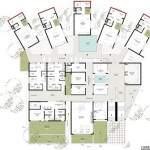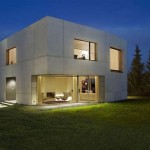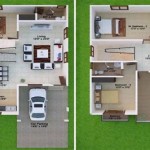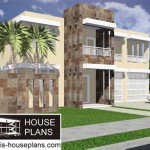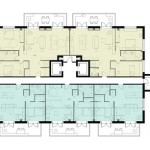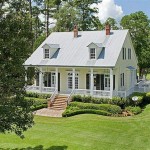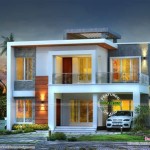Two-Bedroom House Plan With Elevation Above Garage: Optimizing Space and Design
The concept of a two-bedroom house plan with elevation above a garage presents a compelling solution for homeowners seeking efficient use of land and a functional living space. This design configuration, often referred to as an ADU (Accessory Dwelling Unit) when located on an existing property, combines the practicality of a garage with the comfort of a living space, offering a blend of convenience and privacy. These plans are particularly attractive for smaller families, individuals, or as rental properties, maximizing the potential of a property without requiring extensive ground footprint.
Designing a two-bedroom house above a garage requires careful consideration of several factors, including structural integrity, accessibility, zoning regulations, and interior layout. Achieving a cohesive and aesthetically pleasing design involves integrating the garage structure seamlessly into the overall architectural design of the house. This article explores the key elements involved in creating an effective two-bedroom house plan with elevation above a garage, highlighting the advantages, design considerations, and potential challenges.
Key Considerations for Structural Integrity and Safety
The foundation and supporting structure of a house built above a garage must be robust enough to bear the weight of the living space. This requires a detailed structural analysis by a qualified engineer to ensure the safety and stability of the building. The design must account for live loads (occupants, furniture) and dead loads (weight of the building materials). The existing garage may require reinforcement, particularly if it was not originally designed to support additional weight on top.
Specific aspects of structural consideration include the type of foundation, the materials used for the walls and floor joists, and the method of load transfer from the upper level to the foundation. Options like reinforced concrete slabs, steel beams, and engineered wood products are often employed to provide the necessary strength. Fire safety is another critical element. Building codes typically mandate fire-resistant materials and proper insulation between the garage and the living space above to prevent the spread of fire and smoke. This may involve installing a fire-rated ceiling in the garage and fire-resistant drywall on the walls.
Furthermore, proper ventilation is crucial to prevent the buildup of carbon monoxide and other harmful fumes from vehicles. The design must include adequate ventilation in the garage and a sealed barrier between the garage and the living space to prevent fumes from entering the house. Carbon monoxide detectors should be installed in both the garage and the living space to provide an early warning system.
Optimizing Space and Layout for Functionality
Designing a two-bedroom house plan above a garage necessitates innovative space planning to maximize functionality and comfort within a limited footprint. The layout should prioritize natural light, efficient circulation, and separation of living and sleeping areas. Open-concept living spaces are a popular choice, as they create a sense of spaciousness and facilitate social interaction.
The placement of windows and doors should be carefully considered to optimize natural light and ventilation. Skylights can also be incorporated to bring additional light into the interior. The positioning of the staircase leading from the garage to the living space is a key element in the overall design. It should be easily accessible from both the garage and the house, and it should not obstruct the flow of traffic within the living space. A well-designed staircase can also serve as an architectural feature, adding visual interest to the interior.
Storage is another crucial aspect of space planning. Built-in storage solutions, such as closets, shelves, and cabinets, can help to maximize space and minimize clutter. Utilizing vertical space by incorporating high ceilings or loft areas can also create additional storage or living space. The design should also consider the specific needs of the occupants. A home office, a laundry room, or a guest bathroom may be incorporated into the layout, depending on the available space and the preferences of the homeowner.
Elevation and Aesthetic Design Considerations
The elevation of a two-bedroom house plan above a garage is a critical aspect of the overall design, influencing both the aesthetic appeal and the functional aspects of the building. The elevation refers to the exterior appearance of the house, including the roofline, windows, doors, and exterior materials. A well-designed elevation can blend seamlessly with the surrounding environment and enhance the curb appeal of the property.
The choice of exterior materials plays a significant role in the overall aesthetic. Options include siding, brick, stucco, stone veneer, and wood. The materials should be durable, weather-resistant, and aesthetically pleasing. The color scheme should be carefully considered to complement the surrounding landscape and architectural style. The roofline is another important element of the elevation. Common roof styles include gable, hip, shed, and flat roofs. The roofline should be proportioned to the size and shape of the building, and it should provide adequate drainage to prevent water damage.
Window and door placement is crucial for both aesthetic and functional reasons. The size and shape of the windows should be proportionate to the size of the building, and they should be strategically placed to maximize natural light and ventilation. The front door should be welcoming and inviting, and it should complement the overall architectural style. Landscaping can also play a significant role in enhancing the elevation of the house. Planting trees, shrubs, and flowers can soften the lines of the building and create a more inviting atmosphere. Exterior lighting can also be used to highlight architectural features and improve safety and security at night.
Accessibility is a critical design consideration, particularly for homeowners with mobility issues. Ramps or elevators may be necessary to provide access to the living space above the garage. The design should comply with accessibility guidelines, such as the Americans with Disabilities Act (ADA), to ensure that the house is accessible to everyone. Consideration should also be given to the location of the garage entrance in relation to the house. Ideally, the garage entrance should be close to the house entrance to minimize the distance that occupants must travel in inclement weather. The driveway should be wide enough to accommodate vehicles and provide adequate space for maneuvering.
Environmental sustainability is an increasingly important consideration in house design. Incorporating sustainable design features can reduce the environmental impact of the house and lower utility costs. Energy-efficient windows and doors can help to reduce heat loss in the winter and heat gain in the summer. Solar panels can be installed on the roof to generate electricity, and a rainwater harvesting system can be used to collect rainwater for irrigation. The design should also consider the use of sustainable building materials, such as reclaimed wood and recycled content insulation.
Zoning regulations often dictate the allowable size, height, and setbacks for houses built above garages. It is essential to consult with local planning authorities to ensure that the design complies with all applicable regulations. Zoning regulations may also restrict the use of the house, particularly if it is intended to be used as a rental property. It's imperative to check local ordinances regarding ADUs and rental permits before proceeding with any construction.
The cost of building a two-bedroom house above a garage can vary depending on several factors, including the size of the house, the materials used, and the complexity of the design. It is essential to develop a detailed budget and to obtain multiple bids from contractors before starting construction. The budget should include the cost of materials, labor, permits, and engineering fees. It is also important to factor in a contingency fund to cover unexpected expenses that may arise during construction.
Designing a two-bedroom house plan with elevation above a garage involves careful planning and attention to detail. By addressing the structural, spatial, aesthetic, and environmental considerations outlined in this article, homeowners can create a functional and aesthetically pleasing living space that maximizes the potential of their property. Thorough research, professional consultation, and a commitment to quality construction are essential for a successful outcome. This design option offers a versatile solution for various housing needs, providing a balance of affordability, efficiency, and architectural ingenuity.

Extended 2 Car Two Story Garage Plan W Apartment Option

12 Simple 2 Bedroom House Plans With Garages Houseplans Blog Com

632 Square Foot 2 Bed 1 Bath Above Garage House Design Plans For Dwg Files Instant

Modern House Plan 2559 00669

12 Simple 2 Bedroom House Plans With Garages Houseplans Blog Com

Delightful Two Story House Plan With Loft Above Garage 39280st Architectural Designs Plans

632 Square Foot 2 Bed 1 Bath Above Garage House Design Plans For Dwg Files Instant

Plan 85372 Popular Garage Carriage House With Living Space

Garage With Large Apartment 2 Car Bedrm 900 Sqft Plan 187 1210

Garage Apartment Plans Living

